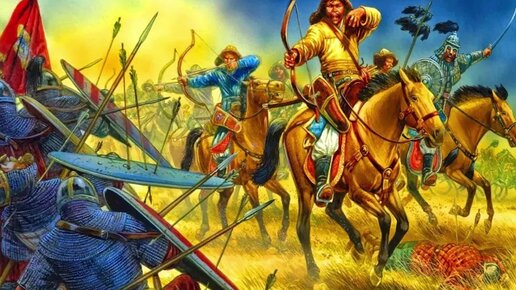During the formation of the Second Bulgarian Kingdom in the Balkans, the Bulgarians had a new ally, and they were the Kipchaks. They were reliable co-religionists who took part in many of the major battles of the Bulgarians against various rivals. Part of the Kipchak tribes later mixed with the Danube Bulgarians.
The Kipchaks first appeared in the Balkans under the Byzantine dynasty of the Comneni. These tribes settled in the area of Shumen and White Sea. It was then that Kipchaks were first mentioned in Bulgarian chronicles. In 1186 the Bulgarian tsar Ivan Asen I with an army, half of which were Kipchaks was able to defeat the Byzantines. Then the Kipchak army reached the city of Agafopol, but then was thrown back by the Byzantines. Then there was a battle in the area between Vasternae and Verroya, where the Byzantines were defeated. Bulgarian-Kipchak forces captured the lands between the Danube and the Rhodope Mountains. There is an assumption from researchers that the Bulgarian kings Peter and Asen were of Bulgarian-Kipchak origin.

Map of campaigns of tsar Ivan Aseni II. Photo from free sources on the Internet.
Some time later, the Byzantine Emperor Isaac II Angel sent his naval flotilla to prevent the Kipchaks from realising aid to the Bulgarians. But this action of sea forces of Byzantium did not succeed. Among Byzantines panic began because of rumours about approaching Kipchaks.
Bulgarian tsar Kaloyan was married to the daughter of a Kipchak khan, and under his rule Kipchaks occupy high positions in the royal court.

Anthropological reconstruction of the face of Tsar Kaloyan made by Prof. Yordan Yordanov. Photo from free sources on the Internet.
In 1190 Bulgarians together with Kipchaks pushed back the Byzantines behind the Rhodope Mountains. Then in 1191 the Bulgarian-Kipchak army defeated the Byzantines on the Morava River. It is known that in 1199 the Kipchaks, together with other peoples, were able to occupy many Rakian towns between Mesina and Tsurul. On 23 April 1199 Bulgarians together with Kipchaks and Wallachians have approached closely to Constantinople. In Battle near Adrianople in 14 April 1205 Bulgarian-Kipchak army has defeated crusaders of IV Crusade and has captured Emperor of Latin Empire Balduin Eno.

Emperor Baldwin captured during the Battle of Adrianople. Photo from free sources on the Internet.
In 1205-1207 Bulgarian-Kipchak troops carried out a military campaign in Thrace and Macedonia. The Latin Emperor Henry of Flanders managed to defeat Kaloyan’s troops in 1206. However, the Bulgarians and Kipchaks continued their military mission until April 1207. But in 1207, during the siege of the city of Thessalonica, King Kaloyan was killed.

Peter and Asen. Part of a fresco by Bulgarian artist Georgi Bogdanov. Photo from free sources on the Internet.
During the Mongol invasions, a new wave of Kipchak tribes arrived in the Balkans. Researchers believe that the Kipchaks were settled then by the Bulgarian tsar Ivan Asen II in Eastern Thrace to protect the borders of Bulgaria from the Byzantines and Latins. The next military campaign of the Kipchaks took place in 1230, when during the Battle of Klokotnitsa they came to the aid of Ivan Asen II’s troops.
It so happened that the third wave of Kipchak migration to Bulgaria took place after the sad events in Hungary in 1241, when the Kipchak Khan Kotyan was killed. The Kipchaks then crossed the Danube and settled in Bulgarian and Byzantine lands. Gradually the Kipchaks became subjects of the Bulgarian kingdom, occupying high positions, and later assimilated with the Bulgarian population.
